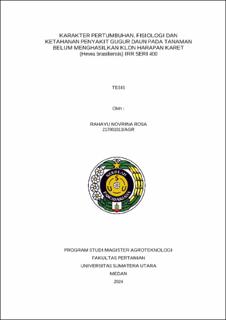Karakter Pertumbuhan, Fisiologi dan Ketahanan Penyakit Gugur Daun pada Tanaman Belum Menghasilkan Klon Harapan Karet (Hevea brasiliensis) IRR Seri 400
Growth Characters, Physiology and Leaf Fall Disease Resistance in Immature Plants of Rubber (Hevea brasiliensis) IRR 400 Series Clones

Date
2024Author
Rosa, Rahayu Novrina
Advisor(s)
Basyuni, Mohammad
Siregar, Luthfi Aziz Mahmud
Metadata
Show full item recordAbstract
Rubber is Indonesia's leading commodity because it supports much of the country's economy. Superior rubber clones are currently being used extensively in Indonesia, but actual productivity results vary. With a smallholder rubber area and production of 3,316,047 ha in 2020 and a current productivity of 1,022 kg/ha, this productivity is still very low when compared to the results obtained by large state plantations with only 138,594 ha and a productivity of 1,152 kg/ha and private plantations with a land area of 237,710 ha and a productivity of 1,225 kg/ha. This low productivity can be attributed to the use of non-standard planting materials. The adaptation test is the final stage of the selection cycle was aimed of this study to determine the suitability of growing clones in an environment with special characteristics determined by genetic factors and expressed in the form of morphological and physiological processes that support growth, yield potential, and adaptability to a wider environment in order to explore the potential advantages of a clone. This study was carried out at the PT Socfindo Tanah Besih plantation and the Sungei Putih Research Unit's Physiology and Protection Laboratory using non-factorial completely randomized design that was planted in 2019. In this study, four rubber clones from the IRR 400 series, as well as clones PB 217 and PB 330 for comparison, were tested. The clones IRR 434 and IRR 440 had the best plant growth, with trunk girth sizes of 40.99 cm and the highest growth rate of 9.06 cm/year. IRR 400 series clones are categorized as clones that are quite resistant to leaf fall disease (Corynespora, Colletotrichum, Oidium and Pestalotiopsis).
Collections
- Master Theses [428]
